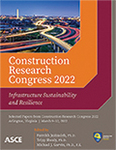Homeowners’ Motivations to Invest in Energy-Efficient Technologies in Residential Buildings of Rural Midwest America
Publication: Construction Research Congress 2022
ABSTRACT
Energy-efficient technologies provide the means for improving energy performance and reducing the operating costs of buildings. In this study, energy-efficient technologies include smart thermostats, LED lighting, weatherization, and EnergyStar-rated appliances. While there is significant evidence regarding the benefits of energy-efficient technologies, not all homeowners decide to invest in such technologies. Motivations behind the adoption of energy-efficient technologies have been widely studied among homeowners, but previous research has primarily focused on urban and suburban areas. Limited literature exists on homeowners’ motivations to invest in energy-efficient technologies in rural areas of the US. Rural housing is generally older and less energy-efficient. Generally, households have a lower average income. This suggests that while housing may be in greater need of efficiency upgrades, financing such upgrades may be less attainable for some households. This study adopted a qualitative approach in six rural communities in Iowa (Boone, Nevada, Pella, Solon, Swisher, and Williamsburg), focusing on owner-occupied homes, hereafter referred to as homeowners. The interviews included twenty-five (N = 25) small-town rural homeowners. Through narrative analysis, results show that the motivation to invest in energy-efficient technologies was primarily related to renovation factors, financial factors, and behavioral factors. The qualitative data obtained from the interviews provide a more detailed description of rural homeowners’ motivation to invest in energy-efficient technologies, which can guide policymakers and designers in providing more accurate programs that consider rural homeowners’ motivations.
Get full access to this article
View all available purchase options and get full access to this chapter.
REFERENCES
Abdmouleh, Z., Gastli, A., and Ben-Brahim, L. (2018). Survey about public perception regarding smart grid, energy efficiency & renewable energies applications in Qatar. Renewable and Sustainable Energy Reviews, 82, 168–175.
Allen, M. 2017. The SAGE Encyclopedia of Communication Research Methods. https://dx.doi.org?10/4135/9781483381411.n368.
Bamberg, M. (2012). Narrative analysis.
Brounen, D., Kok, N., and Quigley, J. M. (2012). Residential energy use and conservation: Economics and demographics. European Economic Review, 56(5), 931–945.
Cattaneo, C. (2019). Internal and external barriers to energy efficiency: which role for policy interventions?. Energy efficiency, 12(5), 1293–1311.
Day, J. K., McIlvennie, C., Brackley, C., Tarantini, M., Piselli, C., Hahn, J., O'Brien, W., Rajus, V. S., De Simone, M., Kjærgaard, M. B., and Pisello, A. L. (2020). A review of select human-building interfaces and their relationship to human behavior, energy use and occupant comfort. Building and environment, 178, 106920.
Egbelakin, T., and Wilkinson, S. (2008). Factors affecting motivation for improved seismic retrofit implementation. In Australian Earthquake Engineering Conference (AEES).
Egbelakin, T., Wilkinson, S., and Ingham, J. (2014). Economic impediments to successful seismic retrofitting decisions. Structural Survey.
Guta, D. D. (2020). Determinants of household use of energy-efficient and renewable energy technologies in rural Ethiopia. Technology in Society, 61, 101249.
Gerhardsson, K. M., Laike, T., and Johansson, M. (2019). Residents’ lamp purchasing behaviour, indoor lighting characteristics and choices in Swedish homes. Indoor and Built Environment, 28(7), 964–983.
Guta, D. D. (2020). Determinants of household use of energy-efficient and renewable energy technologies in rural Ethiopia. Technology in Society, 61, 101249.
Kastner, I., and Stern, P. C. (2015). Examining the decision-making processes behind household energy investments: A review. Energy Research & Social Science, 10, 72–89.
Trotta, G. (2018). Factors affecting energy-saving behaviours and energy efficiency investments in British households. Energy Policy, 114, 529–539.
Koupaei, D. M., Song, T., Cetin, K. S., and Im, J. (2020). An assessment of opinions and perceptions of smart thermostats using aspect-based sentiment analysis of online reviews. Building and Environment, 170, 106603.
Levitt, H. M., Bamberg, M., Creswell, J. W., Frost, D. M., Josselson, R., and Suárez-Orozco, C. (2018). Journal article reporting standards for qualitative primary, qualitative meta-analytic, and mixed methods research in psychology: The APA Publications and Communications Board task force reported. American Psychologist, 73(1), 26.
Nair, G., Gustavsson, L., and Mahapatra, K. (2010). Owners perception on the adoption of building envelope energy efficiency measures in Swedish detached houses. Applied Energy, 87(7), 2411–2419.
National Association of State Energy Officials. (2020). Rural Data Resources for State Energy Planning and Programs.
Powers and Duties of Cities. (2020, November 24). The Iowa Legislature. Retrieved April 11, 2021, from https://www.legis.iowa.gov/docs/code/364.17.pdf.
Santos, C., and Cetin, K. (2020). Energy Efficiency Rebate Programs: An assessment of investment behaviors by homeowners. Residential Building Design and Construction Conference, 295–306
Sommerfeld, J., Buys, L., and Vine, D. (2017). Residential consumers’ experiences in the adoption and use of solar PV. Energy Policy, 105, 10–16.
USDA. (2017). Rural America at a Glance- 2017 Edition. Retrieved April 11, 2021, from https://www.ers.usda.gov/webdocs/publications/85740/eib182_brochure%20format.pdf?v=5538.2.
Xie, W., Chen, C., Li, F., Cai, B., Yang, R., Cao, L., Wu, P., and Pang, L. (2021). Key Factors of Rural Households’ Willingness to Pay for Cleaner Heating in Hebi: A Case Study in Northern China. Sustainability, 13(2), 633.
Yang, S., Zhang, Y., and Zhao, D. (2016). Who exhibits more energy-saving behavior in direct and indirect ways in china? The role of psychological factors and socio-demographics. Energy Policy, 93, 196–205.
Information & Authors
Information
Published In
History
Published online: Mar 7, 2022
Authors
Metrics & Citations
Metrics
Citations
Download citation
If you have the appropriate software installed, you can download article citation data to the citation manager of your choice. Simply select your manager software from the list below and click Download.
